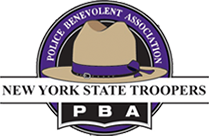PBA members are very proud of their preeminent role in virtually all levels of law enforcement in New York State. We were very proud of the fact that the Sunday February 19th NY Times article about the drug trade on Native American reservations highlighted the enforcement efforts of State Police members. There was a picture accompanying the article of Trooper William P. Collins, SP Winthrop, guarding defendant John V. Oakes, who has been accused of being a major level drug trafficker. The New York Times is one of the world’s most prestigious newspapers and again, we are very proud of the fact that their Sunday edition had a major article directly related to the excellent work of PBA and BCI members.
|
|||||
The man, John V. Oakes, like a fast-rising number of American Indian drug traffickers across the country, saw himself as "untouchable," as one senior investigator put it, protected by armed enforcers and a code of silence that ruled the reservation. After he was finally arrested last May, Oakes was recorded from jail talking on the phone with his estranged wife. "I can’t believe people let this happen to me," he said, according to Derek Champagne, the Franklin County district attorney who listened to the recorded call. "You can’t touch me. I’m on the reservation, and I do what I want."
Investigators described Oakes as an intimidating trafficker who concentrated on stealing drugs and cash from a prosperous and growing cluster of criminals who, like Oakes, have built sprawling mansions near worn-down trailers on this reservation straddling the Canadian border.
Law enforcement officials across the country say Oakes and the drug lords he is accused of stealing from are part of a violent but largely overlooked wave of trafficking and crime that has swept through the nation’s Indian reservations in recent years, as large-scale criminal organizations have found havens and allies in the wide-open and isolated regions of Indian country.
In the eyes of law enforcement, reservations have become a critical link in the drug underworld, helping traffickers transport high-potency marijuana and Ecstasy from eastern Canada into cities like Buffalo, Boston and New York and facilitating the passage of cocaine and methamphetamine from cities in the West and Midwest into rural America.
In some cases, outside drug gangs work with Indian criminals to distribute drugs on Indian and non-Indian lands, and on a growing number of reservations, drug traffickers — particularly Mexican criminals — are marrying Indian women to establish themselves on reservations.
At the Lac Courte Oreilles reservation in northwestern Wisconsin, for instance, several members of the Latin Kings gang married Indian women while a tribal offshoot of the gang built a $3 million crack cocaine ring moving drugs from Milwaukee into and around the reservation over the past few years, prosecutors said.
Increasingly, American Indians are breaking away to build their own violent, Mafia-like enterprises, according to an examination of dozens of court records and interviews with more than 50 federal and local prosecutors, tribal law enforcement officials and tribal members.
For traffickers of marijuana, cocaine, methamphetamine, painkillers and people, reservations offer many advantages. Law enforcement is spotty at best. Tribal sovereignty, varying state laws and inconsistent federal interest in prosecuting drug crimes create jurisdictional confusion and conflict.
The deep loyalty that exists within tribes, where neighbors are often related, and the intense mistrust of the American justice system make securing witnesses and using undercover informants extremely difficult. And on some reservations, Indian drug traffickers have close relationships with tribal government or law enforcement officials and enjoy special protection that allows them to operate freely, investigators say.
Casino money also has fueled the surge, providing a fast-growing source of customers and well-financed partners for outside drug traffickers.
On the Mohawk land of the St. Regis, a reservation of about 6,000 people on the U.S. side, according to the tribe, investigators estimate that 10 to 15 major Indian criminal organizations, along with outside drug rings, move more than $1 billion annually in high-grade marijuana and Ecstasy across the Canadian border, through the reservation and into the Northeast. Prosecutors say they are catching about 2 percent of that contraband.
Until his arrest, the drug trade afforded Oakes a lifestyle that neighbors on this reservation could barely dream of. He owned a gated compound on the St. Lawrence River, with 16 surveillance cameras, a tricked-out Lincoln Navigator and several speedboats.
Oakes pleaded guilty to selling drugs to undercover agents, after investigators seized from the compound 17,000 tablets of Ecstasy, worth $340,000 on the street, 2 pounds of high-grade marijuana and several shotguns and rifles. But investigators said Oakes was a prime suspect in at least a dozen robberies of drug traffickers, netting him hundreds of thousands of dollars in cash, cocaine and marijuana. He is expected to be sentenced next month to 10 years in state prison, the authorities said.

